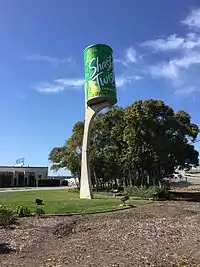Shasta (soft drink)
Shasta Beverages is an American soft drink manufacturer that markets a value-priced soft drink line with a wide variety of soda flavors, as well as a few drink mixers, under the brand name Shasta. The company name is derived from Mount Shasta in northern California and the associated Shasta Springs.
 Shasta Twist decoration at the Shasta headquarters in Hayward, California | |
| Industry | Beverages |
|---|---|
| Founded | 1889, California |
| Headquarters | , United States |
Area served | United States |
| Products | soft drinks, drink mixers |
| Parent | National Beverage Corp. |
| Subsidiaries | Shasta Beverages, Intl., Inc. Shasta Sales, Inc. Shasta Sweetener Corp. Shasta West, Inc.[1] |
| Website | http://www.shastapop.com |
_logo.svg.png.webp) | |
| Type | Soft drink |
|---|---|
| Manufacturer | Shasta Beverages |
| Flavor | various |
| Website | www |
History
Shasta began as The Shasta Mineral Springs Company at the base of Mt. Shasta, California, in 1889. In 1928, the name was changed to The Shasta Water Company. It produced bottled mineral water from Shasta Springs in Northern California. The water was poured into glass-lined railroad cars and shipped off for local bottling.
In 1931, Shasta produced its first soft drink, a ginger ale. Until the 1950s, the company's products were mainly mixers for alcoholic drinks: mineral water, club soda, and ginger ale.

Shasta introduced new marketing strategies in the 1950s,[2] which became industry standards: the packaging of soft drinks in cans, the introduction of low-calorie (i.e., “diet”) soft drinks, and the distribution of cans and bottles directly to grocers through wholesale channels.[3]
By the 1960s, Shasta was a well-known brand of sodas and mixers in most of the western United States and parts of the Southwest. During the 1960s, Shasta was purchased by Consolidated Foods (later known as Sara Lee) and was renamed Shasta Beverages. In 1985, it was acquired by the National Beverage Corp., which also owns the similarly marketed Faygo line of soft drinks.[4]
Advertising
In the early 1980s, Shasta was expanding nationally and increasing advertising spending. In 1983, the company's ad agency hired Ministry frontman Al Jourgensen (at the time a rising synth pop musician) to write and perform a jingle for a commercial.[5]
Products
In addition to soft drinks, Shasta Beverages produces club soda and tonic water for mixing alcoholic drinks.
Soda flavors and mixers
Shasta Beverages currently produces 34 varieties of soft drinks and mixers:[6]
|
|
|
Discontinued flavors
These are the soft drink flavors that have been discontinued by Shasta Beverages, including a line of flavors targeting Hispanic consumers(‡) that was introduced in 2007.
|
|
In 1993, Shasta Beverages offered flavors such as Mario Punch and Princess Toadstool Cherry,[7] which were produced in 8-ounce cans and marketed to children.
From 2003 to 2006, Shasta Beverages sold soft drinks called Shasta Shortz that were also marketed to children. Shasta Shortz products were produced in 8-ounce cans and had sweeter, more candy-like flavors,[8] including Bubble Gum, Camo Orange Creme, Chillin' Cherry Punch, Cotton Candy, Rah-Rah Root Beer, and Red Grape Stain.
Ingredients
Shasta Beverages uses high-fructose corn syrup as the sugar source in their drinks. Shasta diet soft drinks use sucralose and acesulfame potassium as non-nutritive sweeteners. Some of their sugar-based drinks, including their cola, use a combination of high-fructose corn syrup and sucralose. Ingredients for some of their sodas are as follows[9] (in decreasing order by % of product):
- Diet Cola: carbonated water, caramel color, phosphoric acid, citric acid, potassium citrate, sucralose, potassium benzoate (a preservative), caffeine, acesulfame potassium, natural flavor
- Root Beer: carbonated water, high-fructose corn syrup, caramel color, natural and artificial flavors, potassium benzoate (preservative), sucralose[10]
- Tiki Punch: carbonated water, high-fructose corn syrup, citric acid, potassium benzoate, gum acacia, natural and artificial flavor, glyceryl abietate, red 40
- Orange Soda: carbonated water, high-fructose corn syrup, citric acid, potassium benzoate (preservative), modified corn starch, glyceryl acetate, natural flavor, yellow 6, vitamin C (ascorbic acid), sucralose, calcium disodium EDTA, red 40[11]
- Black Cherry: carbonated water, high-fructose corn syrup, citric acid, natural and artificial flavors, potassium benzoate (preservative), caramel color, red 40, sucralose, blue 1
- Creme Soda: carbonated water, high-fructose corn syrup, potassium benzoate, citric acid, caramel color, artificial flavor, sucralose
References
- National Beverage Corp. Annual Report 2017. National Beverage Investor Relations 2017. Retrieved 20 December 2020.
- "History — Shasta". Shastapop.com. Retrieved 2012-10-22.
- Jorgensen, Janice (1994). Encyclopedia of Consumer Brands: Consumable products — Google Books. ISBN 9781558623361. Retrieved 2012-10-22.
- Grant, Tina (2007). International Directory of Company Histories. ST JAMES Press. p. 268. ISBN 978-1-55862-592-1.
{{cite book}}: CS1 maint: date and year (link) - Jourgensen, Al (2014). Ministry : the Lost Gospels According to Al Jourgensen. New York: Da Capo Press. p. 57. ISBN 9780306824647. Retrieved 14 January 2023.
- Shasta Beverages, Inc. “Flavors”. National Beverage Corp. 2020. Retrieved 20 December 2020.
- "Sarasota Herald-Tribune". Retrieved 2013-03-05.
- "Mini Cans: Less is More". Businessweek. 2006-04-12. Archived from the original on April 15, 2006. Retrieved 2012-10-22.
- product nutrition labels, ca. 2011
- label on bottle
- product label (2017)